CNPS SCV Nursery History
The CNPS SCV Nursery was started in 1995 when Jean Struthers got a $10,000 grant from the Packard Foundation to build a nursery for the chapter. With that grant and the donation of some fencing left over from a Christmas tree lot, the nursery was started at Hidden Villa. The following excerpts starting from the July-August 1995 isssue of the Blazing Star trace the development of the Nursery.
Read more ...
Osmaronia cerasiformis - Oso berry [May 6, 2016]
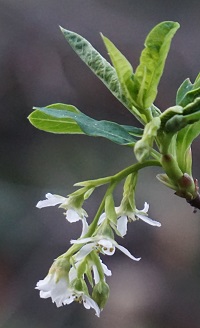 Oemleria cerasiformis (Oso berry)
Oemleria cerasiformis (Oso berry)
Family: Rosaceae
Genus: Oemleria
Common names: Oso berry, Indian plum
This underutilized plant can be cultivated as either a shrub or small tree. It grows up to 12 feet tall and 8 feet wide when mature.
It is deciduous but forms bright green leaves in early spring. It develops flowers at the same time, with cascades of small white flowers appearing as soon as February. Bloom can continue for a couple months and is followed by fruit in late spring and early summer.
One of its common names, Indian plum, comes from its fruit, which resemble small plums when ripe. Its fruit is popular with birds making it a great addition to a habitat garden.
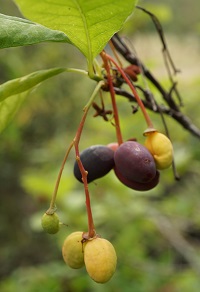
This plant is dioecius, which means that male and female flowers bloom on different plants. You must have at least one of each before the female plants will set fruit. Both male and female plants produce flowers, although the male flowers tend to be a bit showier. Some people think the scent of the male flowers is unpleasant, while the female flowers are said to smell like watermelon.
Oso berry prefers loamy soil, but will tolerate clay. In the wild, it is usually found in moist areas, and it will grow more quickly when provided with water. It is able to handle dry conditions once established. It prefers light shade, but can tolerate full sun.
The Life of a CNPS SCV Nursery Plant
When you buy a plant at our nursery, you’re getting the result of a year or more of careful nurturing by our volunteers.
Our plants are grown from both seeds and cuttings, which we obtain from our stock area, commercial growers and CNPS members. We don’t focus on a specific area of the California Floristic Province, so we grow plants for a wide variety of environments from many regions of California – in addition to a wide variety of local natives, we also raise plants from the mountains, deserts and wetlands.
Read more ...
Pollinators and Blooming Beauties [9/16/2015]
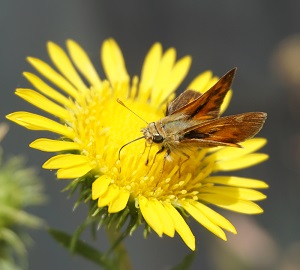
What's Blooming in the Nursery
Most of the time, these articles will be about specific plants that we think you would enjoy adding to your garden. But sometimes, we can't resist sharing the wonders that we see as we work in the nursery. This week the Grindelia camporum (Great Valley gumweed) was a pollinator magnet. Skippers, bees and flies (masquerading as bees) were busily feasting.
Of course, the parade of flowers didn't end there. A few of the others on display included:
- Achillea millefolium (common yarrow) - the Island Pink variety was eye-poppingly bright
- Corethrogyne filaginifolia (common sandaster)
- Dendromecon harfordii (bush poppy)
- Diplacus X (hybrid monkeyflower)
- Epilobium canum (California fuschia)- in addition to the usual reds, 'Summer Snow' brings white into the mix
- Ericameria nauseosa (rubber rabbitbrush)
- Eriogonum (buckwheat) - a huge selection of these wonderful summer and fall bloomers continue to put on a show.
- Monardella macrantha (hummingbird monardella)
- Monardella villosa (coyote mint)
Read more ...
Milkweed (Asclepias) [August 31, 2015]
Milkweed (Asclepias) is the primary host plant for Monarch butterfly caterpillars. Planting locally native milkweed in your garden will provide much needed habitat for these beautiful insects. There are fifteen species of milkweed that are native to California. The Nursery currently grows two of them. More information about California milkweeds is available from the Xerces Society.
Keep in mind that a single plant is usually not enough to provide habitat for butterflies, and providing multiple species of milkweed is better than one. In her book, The California Wildlife Habitat Garden, Nancy Bauer recommends including at least three plants of each species grown.
Asclepias fascicularis (Narrow-leaved Milkweed)
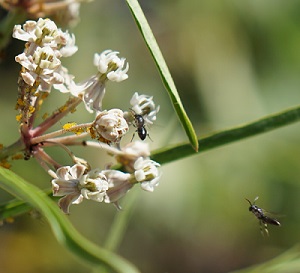 As one might guess from its name, this milkweed has narrow leaves that grow up to five inches long. They are fairly tall plants, growing up to three feet tall with multiple stems topped with clusters of white and pink flowers from June through September.
As one might guess from its name, this milkweed has narrow leaves that grow up to five inches long. They are fairly tall plants, growing up to three feet tall with multiple stems topped with clusters of white and pink flowers from June through September.
This is the most adaptable of the California milkweeds, growing well in both sun and shade, and tolerating both clay and sand. They even do well under oaks and can be found under them in the wild. With their striking flowers and long blooming season, these are ideal plants for any garden.
They are perennials, but will die back to their roots in the fall. They reemerge from their deep taproot in the spring, putting out additional stems each year.
Although they are known for their relationship with the Monarch butterfly, their flowers are also popular with bees and other pollinators.
More information is available at Mother Nature's Backyard and Las Pilitas.
Asclepias speciosa (Showy Milkweed)
This milkweed is native to the Bay Area and northern California. It has wide fuzzy grey to white leaves and spectacular 4 to 5 inch pinkish-white flower heads. It can grow three or four feet tall, although it tends to grow slowly and may take a couple years to reach full height. It prefers full sun and does not need supplemental water once established.
Like narrow-leaved milkweed, it will die down to the roots in the fall. It usually emerges a bit later than narrow-leaved milkweed, so give it time to come up in late spring to early summer. The bloom period doesn't last as long - flowers tend to appear in June and July. However, the huge, gorgeous flowers more than make up for the shorter length of time.
More information about Showy Milkweed can be found on Calflora and Las Pilitas.
Phytophthora in our Nursery?
By Melanie Cross, Chapter Nursery Manager
8/19/2015
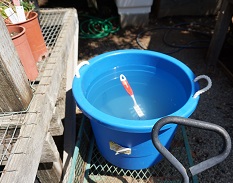 An issue that has surfaced in native plant nursery and revegetation circles this year is the appearance of deadly exotic pathogens: Phytophthora species, and lots of them. You may know of this algae relative because sudden oak death is caused by an airborne species, P. ramorum. The new pathogens that are showing up are water-borne. Susceptible plants at revegetation sites and other landscapes have been devastated by these “plant destroyers.” Unfortunately, nurseries offer the right conditions to cultivate and disseminate them. This is just what we do not want to do.
An issue that has surfaced in native plant nursery and revegetation circles this year is the appearance of deadly exotic pathogens: Phytophthora species, and lots of them. You may know of this algae relative because sudden oak death is caused by an airborne species, P. ramorum. The new pathogens that are showing up are water-borne. Susceptible plants at revegetation sites and other landscapes have been devastated by these “plant destroyers.” Unfortunately, nurseries offer the right conditions to cultivate and disseminate them. This is just what we do not want to do.
Read more ...
Useful Vines for the Garden [August 8, 2015]
Two of the great vines available at the nursery are Vitis californica (California wild grape) and Clematis lasiantha (chaparral clematis). They are both useful habitat plants and can be grown as a ground cover or trained over a trellis or fence. They are tolerant of a wide variety of soils -- from clay to sandy soils.
Clematis lasianta (Chaparral clematis)
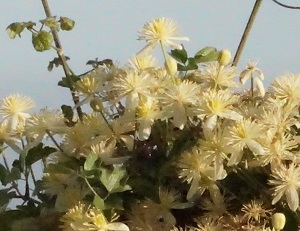 Clematis lasianta, which is also known as chaparral or pipestem clematis, is a lovely vine that is covered with gorgeous white flowers in the spring. The flowers are followed by fluffy white seed heads that make the plants look like they're covered in cottonballs. It can grow fifteen to twenty feet tall. This plant loves full sun although it prefers some shade for its roots. It does not need supplemental water after it is established. It is deciduous and may die back in cold winters, but will quickly grow back in the spring. You can see these vines in flower on many local trails in the spring.
Clematis lasianta, which is also known as chaparral or pipestem clematis, is a lovely vine that is covered with gorgeous white flowers in the spring. The flowers are followed by fluffy white seed heads that make the plants look like they're covered in cottonballs. It can grow fifteen to twenty feet tall. This plant loves full sun although it prefers some shade for its roots. It does not need supplemental water after it is established. It is deciduous and may die back in cold winters, but will quickly grow back in the spring. You can see these vines in flower on many local trails in the spring.
More at Las Pilitas and Calflora.
Vitis californica (California wild grape)
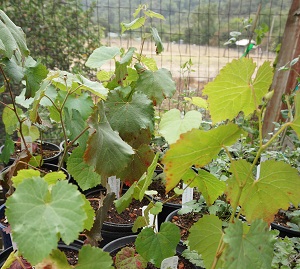
Vitis californica has beautiful, large green leaves that provide an excellent cover in the summer. In the wild, it is typically found along streams and other moist areas, but is adaptable to dry conditions after it is established. It is a deciduous vine that can grow over thirty feet tall. Since it sheds its leaves in the winter, it's great over an arbor or trellis for summer shade and winter sun. It produces bunches of small purple grapes in the fall. The grapes are edible, but tend to be tart.
Maintenance is easy. Agi Kehoe, an active member of the Gardening With Natives subgroup shares these simple pruning instructions:
Winter pruning: thin out the vine by removing all but the major canes that form the structure. Once finished, there should be one mature cane per wire line on a fence, and maybe 3 canes on a 2' wide arbor. Cut the canes back to 2-3 buds, each cut should be 1/4" above the leaf node. This is also the time to secure the large canes to the trellis with ties.
Active growing season pruning: maintain the fast growth. If trained on a fence, prune to keep it close to the fence; if trained on an arbor, leave some fresh green canes hanging down from the arbor to create a softer look.
More at Las Pilitas Nursery and Calflora.
CNPS SCV Nursery
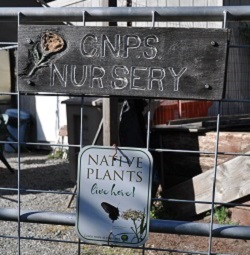
CNPS SCV Nursery
-- founded by Jean and David Struthers
Where ecology and horticulture connect.
The Santa Clara Valley Chapter of CNPS maintains the CNPS SCV Nursery on the grounds of Hidden Villa in Los Altos Hills. Volunteers propagate native plants throughout the year for the chapter's Native Plant Sales. Proceeds from plant sales are the major source of funding for chapter activities. To see what's available, please go to our online store:
https://california-native-plant-society-santa-clara-valley-chapter.square.site/
For more information, contact the Nursery Manager, Vivian Neou at This email address is being protected from spambots. You need JavaScript enabled to view it..
You can learn more about the history of our nursery here.
An illustrated list from Calflora of all the species (this does not include cultivars) grown at the nursery is available here.
Directions: Hidden Villa is located on 26870 Moody Road Los Altos Hills, CA 94022. It is west of Foothill College. From Hwy 280 in Los Altos Hills, take the Moody Road exit and head west. Two miles west of Foothill College, look for the Hidden Villa sign and driveway on the left. Proceed over the bridge, and park in the Dana Center parking lot to your right. Parking is free for volunteers and plant sale customers. The nursery is just beyond the Dana Center. Google Map Link
Open work sessions at our nursery have been canceled indefinitely.
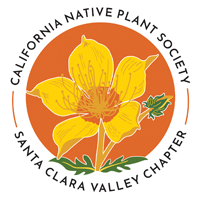

 Oemleria cerasiformis (Oso berry)
Oemleria cerasiformis (Oso berry)

 As one might guess from its name, this milkweed has narrow leaves that grow up to five inches long. They are fairly tall plants, growing up to three feet tall with multiple stems topped with clusters of white and pink flowers from June through September.
As one might guess from its name, this milkweed has narrow leaves that grow up to five inches long. They are fairly tall plants, growing up to three feet tall with multiple stems topped with clusters of white and pink flowers from June through September. An issue that has surfaced in native plant nursery and revegetation circles this year is the appearance of deadly exotic pathogens: Phytophthora species, and lots of them. You may know of this algae relative because sudden oak death is caused by an airborne species, P. ramorum. The new pathogens that are showing up are water-borne. Susceptible plants at revegetation sites and other landscapes have been devastated by these “plant destroyers.” Unfortunately, nurseries offer the right conditions to cultivate and disseminate them. This is just what we do not want to do.
An issue that has surfaced in native plant nursery and revegetation circles this year is the appearance of deadly exotic pathogens: Phytophthora species, and lots of them. You may know of this algae relative because sudden oak death is caused by an airborne species, P. ramorum. The new pathogens that are showing up are water-borne. Susceptible plants at revegetation sites and other landscapes have been devastated by these “plant destroyers.” Unfortunately, nurseries offer the right conditions to cultivate and disseminate them. This is just what we do not want to do. Clematis lasianta, which is also known as chaparral or pipestem clematis, is a lovely vine that is covered with gorgeous white flowers in the spring. The flowers are followed by fluffy white seed heads that make the plants look like they're covered in cottonballs. It can grow fifteen to twenty feet tall. This plant loves full sun although it prefers some shade for its roots. It does not need supplemental water after it is established. It is deciduous and may die back in cold winters, but will quickly grow back in the spring. You can see these vines in flower on many local trails in the spring.
Clematis lasianta, which is also known as chaparral or pipestem clematis, is a lovely vine that is covered with gorgeous white flowers in the spring. The flowers are followed by fluffy white seed heads that make the plants look like they're covered in cottonballs. It can grow fifteen to twenty feet tall. This plant loves full sun although it prefers some shade for its roots. It does not need supplemental water after it is established. It is deciduous and may die back in cold winters, but will quickly grow back in the spring. You can see these vines in flower on many local trails in the spring.
